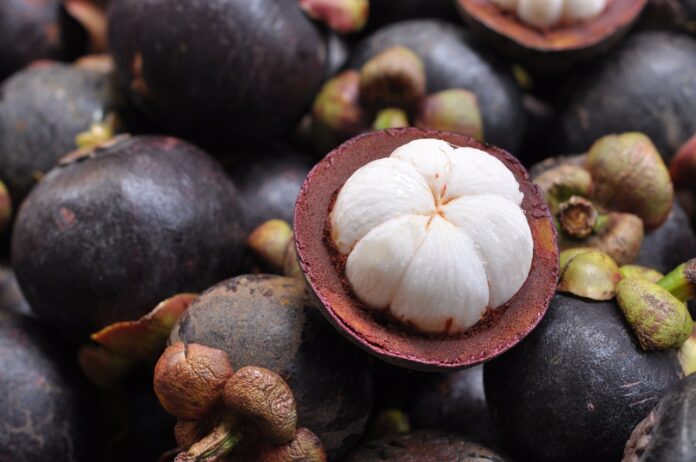Mangosteen, often dubbed the “Queen of Fruits,” is a tropical fruit native to Southeast Asia. It is known for its unique, refreshing taste and an array of health benefits. The fruit has a thick, purple rind and juicy, segmented white flesh that is sweet, tangy, and fragrant. Mangosteen is highly prized in Southeast Asian cultures and is frequently used in traditional medicine, particularly for its antioxidant-rich properties.
Interesting Facts About Mangosteen:
- Origin and Distribution: Mangosteen, scientifically known as Garcinia mangostana, originates from Southeast Asia, particularly Thailand, Malaysia, and Indonesia. It thrives in tropical climates and is a staple in countries like Vietnam, Cambodia, and the Philippines. Due to its preference for humidity and warmth, it’s difficult to grow in cooler climates
- Taste Profile: Mangosteen’s flavor is often described as a perfect balance of sweet and tangy. Its sweetness is reminiscent of ripe strawberries or lychee, while its slight tartness is similar to that of citrus fruits like oranges or tangerines. The flesh is juicy, creamy, and highly refreshing
- Mangosteen is often called the “Queen of Fruits” due to its delicate, sweet taste and nutritional profile. It is highly regarded for its delicious, juicy segments and rich flavor, which combine sweet and slightly tangy notes.
- FDA Ban in the U.S.: Mangosteen was banned in the U.S. in the early 2000s due to concerns about it potentially being a vector for Asian fruit flies. The ban was lifted after implementing irradiation to kill pests
- Hotels Ban: Mangosteen is often banned in hotels in certain regions, particularly in Southeast Asia, due to its strong, pungent odor and the messy nature of its rind. The fruit’s outer shell can stain furniture, fabrics, and carpets, which is why hotels prohibit guests from bringing it into rooms.
- Health Benefits: Mangosteen is highly nutritious, offering a wealth of health benefits. It contains high levels of Vitamin C, known for boosting the immune system, as well as Vitamin B6, folate, and fiber, which promote overall health. The fruit’s antioxidant properties help combat free radicals, protecting cells from oxidative stress
- Health Risks from Overconsumption: While generally safe, excessive consumption of mangosteen can cause health issues, such as gastrointestinal discomfort, constipation, and in rare cases, liver toxicity
- Unique Rind: The tough purple rind of the mangosteen is thick and inedible. While it may look unattractive, the rind contains several health-promoting compounds. Mangosteen rind is sometimes dried and used in teas, supplements, or topical applications for its medicinal properties
- Luxurious Texture: The flesh of the mangosteen is soft, juicy, and creamy, which makes it an indulgent treat. Its texture is similar to a peach or custard, providing a smooth, rich mouthfeel. The segments of flesh are also easy to separate from the rind, making it a hassle-free fruit to enjoy
- Floral Aroma: Mangosteen has a delicate floral fragrance, which adds to its allure. The scent is often compared to a blend of tropical flowers like rose and lavender, making it even more enticing when cracked open
- Staining Properties: While the flesh of mangosteen is sweet and creamy, its outer rind is dark purple and has the potential to stain clothes or surfaces. The juice can leave pinkish stains, so it’s best to enjoy mangosteen with caution near light-colored fabrics
- Exclusivity: Mangosteen is often considered a luxury fruit outside of tropical regions due to its rarity and high cost. Because the fruit is delicate and perishable, it is expensive to transport, making it less common in countries outside Southeast Asia. Specialty markets may carry it, especially in the United States and Europe
